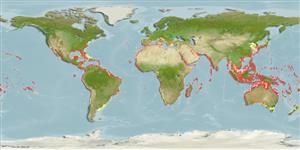Common names from other countries
Classification / Names / Names
आम नाम | उपशब्द | Catalog of Fishes (gen., sp.) | ITIS | CoL | WoRMS
Environment: milieu / climate zone / depth range / distribution range
पारिस्थितिकी
; खारा; गहराई सीमा 0 - 50 m (Ref. 83908). Tropical
Indo-Pacific, Atlantic Ocean and the Mediterranean.
Length at first maturity / आकार / वज़न / Age
Maturity: Lm ? range ? - ? cm
A highly variable species. The typical variety is characterized by short erect branches bearing crowded ramuli with short stalks and oval or spherical tips. The arrangement and shape of the ramuli differ among the numerous varieties.The ramuli can be sparse or dense, arranged radially, alternately, pinnately or irregular on the erect branch. The distal portion of the ramuli can be clavate, turbinate, globose truncate, or sometimes discoid. Plants growing on sandy substrate in calm, turbid water of the reef flat tend to have long erect branches densely covered with clavate or capitate ramuli while those growing on rocky-wave exposed portions of the reef possess strong short erect branches which bear crowded ramuli with spherical or globose tips. Erect branches up to 10 cm in height (Ref. 80758).
Used for human consumption and medicine: antifungal, lowers blood pressure; source of caulerpin, a substance with anaesthetic effect; also source of caulerpicin which has a toxic effect (Ref. 80758); with export potential from Fiji as fresh sea vegetable (Ref. 82232). Edible green seaweed (Ref. 82232). Commonly encountered in lower intertidal and upper subtidal areas protected from strong wave action and current on sandy-muddy to rocky-coralline substrates (Ref. 80758); a dominant feature of clean sandy bottom in the subtidal zone away from freshwater influence, such as at Kaba Peninsula, Fiji (Ref. 82232).
Guiry, M.D. and G.M. Guiry. 2009. (Ref. 80701)
IUCN Red List Status (Ref. 130435)
CITES status (Ref. 108899)
Not Evaluated
Not Evaluated
Threat to humans
Human uses
मात्स्यिकी: व्यापारिक
| FishSource |
साधन
अधिक जानकारी
आम नामउपशब्दपरभक्षीपुनरुत्पत्तिपरिपक्व अवधिमछलीऔ का अंडे देनाFecundityअंडेEgg development
इंटरनेट स्रोत
Estimates based on models
Preferred temperature
(Ref.
115969): 20.8 - 29.2, mean 27.8 (based on 5360 cells).
